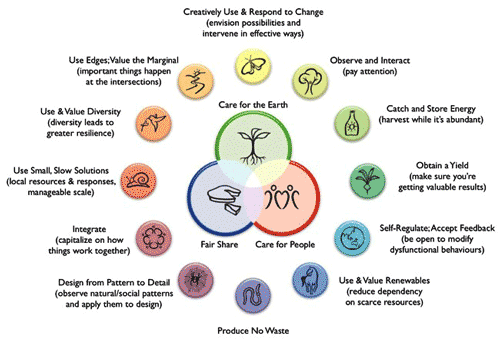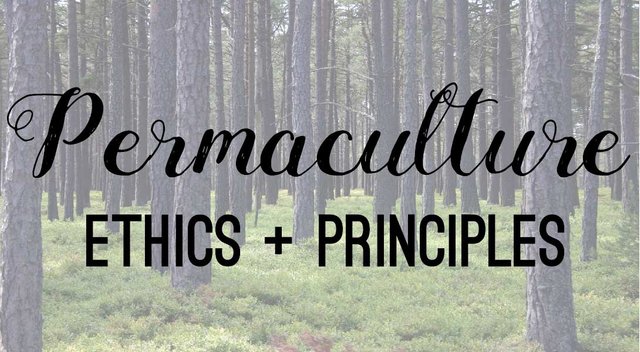Understanding Permaculture Ethics and Prinicples
Permaculture is a word that has been gaining attention lately, but what does it mean and how could it impact your life?
There are many definitions and interpretations of what it is, but at its core it is a way of thinking using a set of ethics and principles that this post will elaborate on.
A Brief History
In the early 70's, a book was published titled Limits to Growth. It spoke about how demand was starting to exceed supply, and brought awareness to the issue of sustainability. Two Australian academics named Bill Mollison and David Holmgren inherently understood this, as they had observed the trend of most food crop being annual and energy intensive. Recognizing the need to shift from this system to a perennial sustainable system, they coined the term permaculture which is an amalgamation of the words permanent and agriculture.
Permaculture 1 was written almost like David Holmgren's thesis. Bill Mollison later quit his job at his university to conduct trials and develop his own syllabus instead of depending on existing academia. Together, they created the foundation that many people have used to build sustainable wholesome lives.
The Ethics
The ethics of permaculture are possibly derived from indigenous cultures revolving around community and encouraging collaboration rather than competition. They cover three simple tenets. Namely,
The Principles
There are 12 different principles behind the permaculture design process. Multiple principles can be applied together and often shows better results than principles used in isolation. For those of you who prefer catchy tunes to reading text, I'll also be linking videos of the band Formidable Vegetable Sound System,an amazing Australian band whose lyrics feature permaculture ideologies. I'll be linking their songs to each principle being discussed where applicable. Hope you have fun listening to their musical reiterations of the following principles.
1. Observe and Interact
In a rush to get started, people often overlook crucial information. This principle reminds us that we need to first understand what's already happening in a system before we try to change it. It involves understanding seasons, wildlife,
rainfall, wind direction and other such factors that one can use to make informed decisions. It also involves engaging with an environment and learning how you affect one another.
2.Catch And Store Energy
This principle reminds us to harness energy at our current disposal for later use. The obvious example is using solar panels or wind turbines for electricity. It isn't limited only to electricity though, as the same principle is utilized by rain water harvesting. Four general areas that energy should be caught and stored in are soil, water, trees and seeds.
3. Obtain A Yield
A yield isn't necessarily only food, and could come in the form of animals, timber, rocks, or even knowledge. This principle reminds us that output should eventually be more than input. Yields will vary for different people, but what is important is getting something of use in exchange for your time.
4. Apply Self Regulation And Accept Feedback
This involves curbing unhealthy habits, and listening to community. It is about collectively choosing to cultivate good behavior and discouraging negativity to keep a system going smoothly. Feedback loops are important, as often we realize way too late that something needed to be changed.
5. Use And Value Renewable Resources And Services
We all know by now that fossil fuel is unsustainable. The best way to shift to a renewable source is to use resources and services that originate from plants, animals and the environment. It is also important to use locally sourced material as often as possible. It makes more sense to build a stone house on a rocky mountainside than on a barren plain. It's about using what we have around us to the best ability rather than be a part of a consumerist society.
6. Produce No Waste
An old idiom states one man's trash is another man's treasure. This principle is about re purposing old materials in new ways. It's about creating a closed loop system where the output of the system is fed back as input for the system.
7. Design From Pattern To Detail
This in essence means you have to look at the big picture. Techniques may vary but the goal has to be envisioned first. It's also about using the many patterns found in nature as inspiration for our designs whose details will be added over time.
8. Integrate Rather Than Segregate
This principle reminds us to stack functions. One thing that has multiple uses is better than multiple things with single uses. It's advised that every element in a design should have three functions, but each function should also have a back up element. It's also about connecting with people and achieving goals through community rather than trying it solo.
9. Use Small And Slow Solutions
This principle reminds us to firstly be patient. It's about being self reliant locally, as a small system requires less maintenance. Incremental changes also have the advantage of proving themselves through feedback. If something goes wrong, there is a possibility to recover.
10. Use And Value Diversity
Variety is the spice of life, as they say. Any ecosystem has a range of biodiversity that maintains it. It's about maintaining a balance between different elements, and valuing the roles of different plants and animals. Multi-cropping is so much better than mono-cropping because a pest infestation will wipe out mono-crops, but only partially affect multi-crops.
11. Use Edges And Value The Marginal
There's two meanings to this principle. The first is to accept so called bizarre ideas, keeping an open mind to alternatives. The second is that any boundary is a place of productivity. Where the river meets the bank for example is a hot spot of biodiversity and productivity.
12. Creatively Use And Respond To Change
Climate change is one of our largest problems, which we will have to face eventually. Similarly, there are many things that exist today that may not tomorrow. Learning to adapt is vital to continue living a sustainable life.
An Example Of Using The Principles
Let's consider a bio-gas drum to supply cooking gas to a household. Observe and interact by noticing the cows feeding cycle, quantity of cow dung, location to place drum etc. Catch and store energy by storing methane to be used as fuel for cooking. Obtain a yield in the form of cooking gas, cow dung,pee and possibly dairy products.
Apply self regulation and accept feedback by learning from mistakes and limiting the quantity of your yields by needs instead of wants. Use and value renewable resources and services by using an animal based source. Produce no waste by reusing animal waste for a useful purpose. Design from pattern to detail by starting with a goal of using bio-gas and working out details like type and size of drum, piping etc as they are needed. Integrate rather than segregate by combing functions. Bio-gas slurry can be used to make bio-fertilizers that can be used to grow vegetables.Use small and slow solutions by using bio-gas for cooking rather than a bought gas cylinder that had to be made in a factory, and then transported to you. Also it will take time to set up. Use and value diversity in this case is not so valid but could be implemented by having different types of cows and different groups of people setting it up. Use edges and value the marginal by starting with the crazy idea of turning poop into cooking fuel. Creatively use and respond to change by being prepared for a shortage, leak or failure of the system and working to overcome issues.

A useful image summarizing all the permaculture ethics and principles
source: http://www.permanentculturenow.com/permaculture-principles/
These principles don't apply only to agriculture, and can be used in other fields as well. In essence, permaculture is simply combining common practicality with design thinking in order to be a wholesome conscious human being. Anyone can incorporate permaculture into their lives to be just a little more self dependent and sustainable.
Exploring Vertical Gardening
The Art Of Fermentation: A Brief Guide





Congratulations! This post has been upvoted from the communal account, @minnowsupport, by soulturtle from the Minnow Support Project. It's a witness project run by aggroed, ausbitbank, teamsteem, theprophet0, someguy123, neoxian, followbtcnews/crimsonclad, and netuoso. The goal is to help Steemit grow by supporting Minnows and creating a social network. Please find us in the Peace, Abundance, and Liberty Network (PALnet) Discord Channel. It's a completely public and open space to all members of the Steemit community who voluntarily choose to be there.
If you would like to delegate to the Minnow Support Project you can do so by clicking on the following links: 50SP, 100SP, 250SP, 500SP, 1000SP, 5000SP. Be sure to leave at least 50SP undelegated on your account.